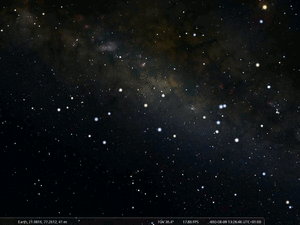Purva Ashadha: Difference between revisions
From All Skies Encyclopaedia
Purva Ashadha
No edit summary |
No edit summary |
||
| Line 2: | Line 2: | ||
[[File:20 PurvaAshadha draw.png|thumb|Purva Ashadha, the 20th nakshatra, as depicted in temples. ]] |
[[File:20 PurvaAshadha draw.png|thumb|Purva Ashadha, the 20th nakshatra, as depicted in temples. ]] |
||
[[File:20+21 stellarium.gif|thumb|The 20th and 21st nakshatra mapped to the star chart (Stellarium). Together, these two asterisms form "The Invincible" in modern Sagittarius. Animated GIF by SMH 2025 for WGSN. Purva A. is the first (right, western).]] |
[[File:20+21 stellarium.gif|thumb|The 20th and 21st nakshatra mapped to the star chart (Stellarium). Together, these two asterisms form "The Invincible" in modern Sagittarius. Animated GIF by SMH 2025 for WGSN. Purva A. is the first (right, western).]] |
||
Purvaṣādha (पूर्व आषाढा) is an Indian name, used by the Indian Vedic tradition. Most of these names are roughly 3000 years old. They pre-date Hinduism but were taken over by it. |
Purvaṣādha (पूर्व आषाढा) is an Indian name, used by the Indian Vedic tradition. Most of these names are roughly 3000 years old. They pre-date Hinduism but were taken over by it. Typically identified with δ and ε Sagittarii. |
||
==Etymology and History== |
==Etymology and History== |
||
Revision as of 07:00, 14 October 2025
Purvaṣādha (पूर्व आषाढा) is an Indian name, used by the Indian Vedic tradition. Most of these names are roughly 3000 years old. They pre-date Hinduism but were taken over by it. Typically identified with δ and ε Sagittarii.
Etymology and History
Name Variants
- Purvaṣādha
- Purva Ashadha
- Jaladaivata,
- Jalarksha
- Apya,
- Toya,
Origin of Constellation
Ashadha means The Invincible and refers to two asterisms in Sagittarius. The First (Purva A.) is depicted as a group of two stars marking a horn or stinger. They are identified with δ and ε Sagittarii, the "arrow" of the Greek and Babylonian archer. The identification of δ is certain because of given coordinates in the 2nd millennium but instead of ε Sgr it could also be γ Sgr (at the tip of the arrow): the three stars form a racognizable pattern.
Transfer and Transformation of the Constellation
Mythology
mnemonic tales and cultural significance
Weblinks
References
- References (general)






